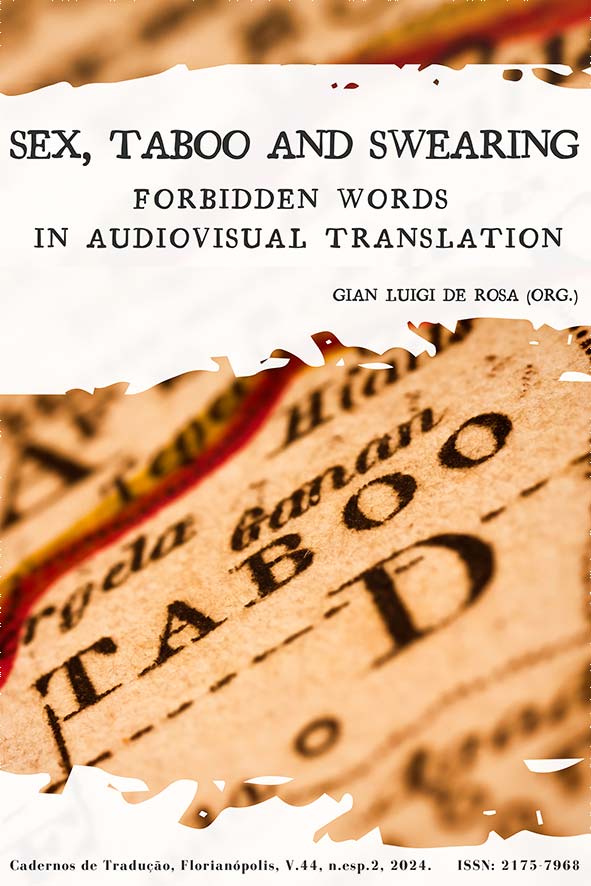Tradutores audiovisuais e o tabu: um estudo de atitudes relativas à tradução para legendagem na televisão portuguesa
DOI:
https://doi.org/10.5007/2175-7968.2024.e99685Palavras-chave:
Estudos de Tradução, Atitudes, Portugal, Televisão, Estratégias de traduçãoResumo
No âmbito dos Estudos da Tradução Audiovisual, vários estudos têm sido dedicados à investigação da tradução da linguagem tabu, na área da dobragem, da legendagem, o fansubbing, e mais recentemente até na área da Acessibilidade. Contudo, esta investigação tem se visto restrita à análise de textos, sendo mais escassa à investigação do agente humano no processo da tradução. Neste enquadramento, este estudo empírico tem por objetivo investigar as atitudes de tradutores audiovisuais relativamente à tradução para legendagem na televisão de sinal aberto em Portugal. Aplicou-se, com esse fim, um questionário a tradutores. Os resultados demostraram um alto nível de concordância com a manutenção do tabu, tal como a relevância de diferentes aspectos relacionados com o papel que o tabu assume nas narrativas fílmicas. Não obstante, estas atitudes diferem da estratégia mais comum na tradução e legendagem de tabu no contexto português, a omissão, o que pode indiciar um novo paradigma na tradução de linguagem tabu.
Referências
Allan, K., & Burridge, K. (2006). Forbidden Words: Taboo and the Censoring of Language. Cambridge University Press.
Alsharhan, A. (2020). Netflix’s No-censorship Policy in Subtitling Taboo Language from English into Arabic. Journal of Audiovisual Translation, 3(2), 7–28. https://doi.org/10.47476/jat.v3i2.2020.127
Ameri, S., & Ghazizadeh, K. (2015). A Norm-Based Analysis of Swearing Rendition in Professional Dubbing and Non-Professional Subtitling from English into Persian. Research in English Language Pedagogy, 3(2), 78–96.
Ávila Cabrera, J. J. (2014). The Subtitling of Offensive and Taboo Language: a Descriptive Study. [Tese de doutorado]. UNED − Universidad Nacional de Educación a Distancia.
Beers Fägersten, K. (2012). Who’s Swearing Now? The Social Aspects of Conversational Swearing. Cambridge Scholars Publishing.
Beseghi, M. (2016). WTF! Taboo Language in TV Series: An Analysis of Professional and Amateur Translation. Altre Modernità, (spe. ed.), 215−231. https://doi.org/10.13130/2035-7680/6859
Briechle, L., & Eppler, E. (2019). Swearword strength in subtitled and dubbed films: A reception study. Intercultural Pragmatics, 16(4), 389−420. https://doi.org/10.1515/ip-2019-0021
Chen, C. (2004). On the Hong Kong Chinese Subtitling of English Swearwords. Meta, 49(1), 135−147. https://doi.org/10.7202/009029ar
Chesterman, A. (2017/2009). The Name and Nature of Translator Studies. In A. Chesterman (Org.), Reflections on Translation Theory: Selected papers 1993–2014 (pp. 323−330). John Benjamins.
Denham, K., & Lobeck, A. (2013). Linguistics for Everyone: An Introduction (2ª ed.). Wadsworth.
Díaz Cintas, J. (2003). Teoría y práctica de la subtitulación: Inglés – Español. Ariel Cine.
Díaz Cintas, J. (2010). Subtitling. In Y. Gambier & L. van Doorslaer (Orgs.), Handbook of Translation Studies (pp. 344−349). John Benjamins.
Díaz Cintas, J., & Remael, A. (2020). Subtitling: Concepts and Practices. Routledge.
Enell-Nilsson, M. (2014). Lost in Translation? Swearing in the Swedish Millennium Films and their German and Finnish Translations. In M. Rathje (Org.), Swearing in the Nordic Countries (pp. 99−124). Dansk Sprognævn.
Ferklová, S. (2014). Subtitles vs. Dubbing: Approaches to Translation of Swear Words and Slang in Film. [Dissertação de mestrado]. Masaryk University.
Filmer, D. (2012). The ‘Gook’ Goes ‘Gay’: Cultural Interference in Translating Offensive Language. InTRAlinea, 14.
García Manchón, P. (2013). A Corpus-Based Analysis of Swearword Translation in DVD Subtitles and Internet Fansubs. [Dissertação de Mestrado]. Universidad Complutense.
Goddard, C. (2015). “Swear words” and “curse words” in Australian (and American) English: At the crossroads of pragmatics, semantics and sociolinguistics. Intercultural Pragmatics, 12(2), 189−218. https://doi.org/10.1515/ip-2015-0010
Han, C., & Wang, K. (2014). Subtitling swearwords in reality TV series from English into Chinese: a corpus-based study of The Family. Translation and Interpreting, 6(2), 1−17. https://doi.org/10.12807/ti.106202.2014.a01
Hjort, M. (2009). Swearwords in Subtitles: A Balancing Act. InTRAlinea Special Issue: The Translation of Dialects in Multimedia.
Holmes, J. S. (2004/1988). The Name and Nature of Translation Studies. In L. Venuti (Org.), The Translation Studies Reader (pp. 172−185). Routledge.
Khoshsaligheh, M., Ameri, S., & Mehdizadkhani, M. (2018). A socio-cultural study of taboo rendition in Persian fansubbing: an issue of resistance. Language and Intercultural Communication, 18(6), 663–680. https://doi.org/10.1080/14708477.2017.1377211
Lie, S. (2013). Translate This, Motherfucker! A Contrastive Study on the Subtitling of Taboo Words. [Dissertação de Mestrado]. Universitetet I Oslo.
McEnery, T. (2006). Swearing in English: Bad Language, Purity and Power from 1585 to the Present. Routledge.
Mattson, J. (2006). Linguistic Variation in Subtitling: The Subtitling of Swearwords and Discourse Markers on Public Television, Commercial Television and DVD. In M. Carroll, H. Arbogast & S. Nauert (Orgs), MuTra: Audiovisual Translation Scenarios (pp. 47−56). University of Copenhagen.
Midjord, M. S. (2013). Swearing in Subtitling. [Dissertação de Mestrado]. Aarhus University.
Özbudak, S. K. (2021). Turkish Subtitling of the F Word on the Digital Streaming Platform: Is There Censorship? Turkish Studies: Language and Literature, 16(3), 1991−2007. https://doi.org/10.7827/TurkishStudies.52152
Roberto, M. T., & Veiga, M. J. (2003). Translating Taboo. In M. Abreu & M. Castro (Orgs.), Estudos de Tradução: Actas de Congresso Internacional. Principia.
Sæther, M. E. (2022). The word bitch in Quentin Tarantino movies subtitled into Norwegian. [Dissertação de Mestrado]. Norwegian University of Science and Technology.
Saldanha, G., & O’Brien, S. (2013). Research Methodologies in Translation Studies. St Jerome.
Sanz-Moreno, R. (2017). La (auto)censura en audiodescripción: El sexo silenciado. Parallèles, 29(2), 46−63. https://doi.org/10.17462/PARA.2017.02.04
Sanz-Moreno, R. (2018). Audiodescription of taboo: a descriptive and comparative approach. SKASE, 11(1), 92−105.
Sanz-Moreno, R. (2020). Audiodescripciones alternativas de sexo: Los usuarios opinan. Lingue e Linguaggi, 35, 295−314. https://doi.org/10.1285/i22390359v35p295
Scandura, G. L. (2004). Sex, Lies and TV: Censorship and Subtitling. Meta: Translators’ Journal, 49(1), 125−134.
Soler Pardo, B. (2011). Swearing and Translation: a study of the insults in the films of Quentin Tarantino. [Tese de doutorado]. Universitat de Valencia.
Xavier, C. (2009). Esbatendo o tabu: estratégias de tradução para legendagem em Portugal. [Dissertação de mestrado]. Universidade de Lisboa.
Xavier, C. (2019). Tabu e Tradução Audiovisual: um estudo descritivo de normas de tradução para legendagem de linguagem tabu em contexto televisivo. [Tese de doutorado]. Universidade de Lisboa.
Downloads
Publicado
Como Citar
Edição
Seção
Licença
Copyright (c) 2024 Cadernos de Tradução

Este trabalho está licenciado sob uma licença Creative Commons Attribution 4.0 International License.
Autores têm autorização para assumir contratos adicionais separadamente, para distribuição não exclusiva da versão do trabalho publicada nesta revista (ex.: publicar em repositório institucional ou como capítulo de livro, com reconhecimento de autoria e publicação inicial nesta revista).





















































